All cutlery aficionados have that grail knife somewhere in the back of their minds.
This Bark River UP Bravo meets all my requirements for a hunting/bushcraft knife, and my search for the grail may be over. Maybe. (See the video below).
by Leon Pantenburg
Fact: The corner hardware store sells knives that are as good as, or better than, anything the mountain men, long hunters, settlers, frontiersmen and buffalo hunters used. The easy solution for your survival/hunting/bushcrafting cutlery quandary is to go buy an Old Hickory™ butcher knife, fashion a sheath and let it go at that.
Another fact: That would be no fun.
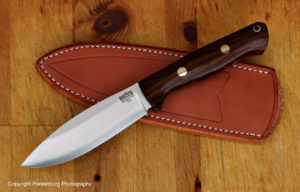
This Upper Peninsula Bravo combines quality design with good looks.
The new UP (for Upper Peninsula of Michigan) Bravo combines a classic blade design with Bark River’s most popular handle. The result is magic.
My appreciation of the Canadian leaf style blade design is well-documented. I have used that blade design for well over 20 years. One of my first Bark River knives was a Canadian. I tried hard to like the handle. In fact, I tried twice, when the Canadian LT came out.
But no knife handle is ergonomic for everyone, and I reluctantly handed them off to friends. My suggestions for a more ergonomic handle on the Canadian blade may have, in a tiny way, helped influence the development of the Ambush Tundra. (Bellyaching, whining, and sniveling seems to have helped.)
For several years, I thought the Ambush Tundra or Bravo 1.25 LT might be the ultimate hunting/wilderness knife for me.
I’ve used both knives as go-tos on hunts and guide trips, and they have always performed to expectations. And those expectations are very high.
My wilderness knife has to be a combination hunting/survival/bushcraft blade. Since I am frequently in a remote swamps, backwaters or western backcountry, weight is an issue. Versatility is another. The knife must be capable of gutting, skinning and quartering a big game animal.
But that doesn’t take away from the bushcraft/survival aspect. On a Mississippi River canoe trip, that same knife may be used for whittling wiener sticks, processing tinder, cutting rope, cleaning fish, digging up roots, etc.
Over the years, my user knife criteria has been refined to this: I want a micarta handle and a four to five-inch blade, convex ground, made of A2 steel. But I also love desert ironwood, walnut, curly maple and other wood handles, and don’t hesitate to take them into the field.
In summary the Bark River UP model hasn’t been wrung out yet, but that will start very soon. I’m anticipating this to be a great knife based on my experience with this blade design, handle and steel.
Here are the specs:
Overall Length: 9.70″
Blade Length: 4.66″
Blade Steel: A2 Tool Steel
Blade Thickness: .156″
Weight: 7.75 Ounces
The good stuff:
Steel: A2 steel was my choice for this knife, and here’s why. I hoped the UP Bravo would be an affordable, hardcore user knife. While I have knives in all the designer super steels, I have a hard time seeing any advantages from the super steels.
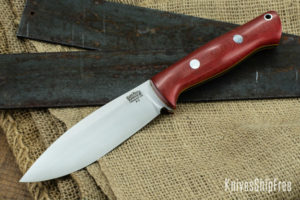
My UP Bravo with the micarta handle shows definite Iowa State University influences.
In my experience the super steels are harder to sharpen, and require more specialized sharpening equipment. A2 and CPM 3V can be sharpened with a smooth rock picked up from a creek bed.
Besides, some of the harder steels are more brittle and tend to chip. I don’t want that in a knife that is going to be used constantly. (Do you need a designer steel in your blade? Here are some thoughts.)
Mike Stewart, president of Bark River Knives, says if he could only use one steel in his knives it would be A2.
“There is nothing wrong about A2,” he commented in a Facebook post. “Extra toughness is kind of moot if you can’t break an A2 blade. Extra edge holding is great but it then takes longer to re-sharpen. I’m afraid we have fallen into the ‘Designer Steel’ trap.”
Handle: I own several Bravos, and I prefer that handle design, even over Bark River’s very popular Aurora.
In working with first responders and other knife users, I find the biggest complaint about knives is too-short handles. I wear size large gloves and my right hand palm measures four-inches across. I want a four-finger grip on a working knife. I don’t want my finger tips to touch my palm when I use a hammer grip. (See photo below. My son is always giving me crap about complaining about too-small knife handles and my big hands. Well, those of us who were raised doing hardcore manual labor don’t have the hands of a pianist.)

Some 30+ years of Taekwondo made my large hands larger. I was a lot younger in this 1979 photo.
Point: The point is centered in the blade. This makes for a real user, either for gutting big game animals or drilling holes in wood. The centered point allows the user to put more pressure, safely, on the tip when drilling.
Grind: After using my first Tundra to help skin an elk, I sent it back to the BR factory to have it re-ground to full convex. The original flat grind with micro bevel was not the best choice for a hunting knife, IMO, and the convex proved to work much better under field conditions.
Both my Tundras were re-ground to full convex at the Bark River factory, and they work really, really well. As far as I’m concerned convex is best.
The UP features a full convex grind, and it is going to work really, really well.
Blade length: For a hunting/wilderness knife a four-to-five inch blade works best for me. (Here is how to determine what blade length will work for you.)
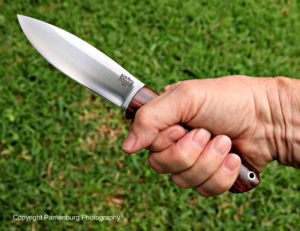
The Bravo handle allows a full four-finger grip, even with gloves on.
Blade thickness: IMHO, a thin blade – say under 1/8-inch – is more useful than some of those thick, sharpened pry bars. I don’t baton firewood and hope I never get into any sort of altercation that includes sharp, pointy objects.
The UP blade thickness is .156 inch, and that seems to be a good compromise between thick and thin. I defer to Mike Stewart’s judgement and experience on this.
Spine: The hump, or bow, or whatever you call it, on the spine of the Canadian design looks weird to people who have never used one. This hump helps keep the point from piercing the entrails when you’re making that initial spine down, edge up incision cut that opens up a deer or elk abdomen. I haven’t tried it, but have been told that the hump also makes the spine work well for fleshing a hide.
The UP spine is ground at a 90-degree angle. This edge works well for shredding tinder or scraping a farro rod to make sparks. Proper use of the spine can help save the opposite edge for other tasks.
Point: The point is another section of blade that needs consideration. To a large extent, the point determines how well the knife will function, and what tasks it is good at.
The UP has a drop point, which is a very useful point for a hunting/survival knife. It is centered in the blade, which makes it good for drilling in wood.
Do you need a UP Bravo?
Like anything, first consider what you will be using the knife for. No knife works best for everyone. My dream knife might be your disappointment.
So is the UP my ultimate grail knife? I have not needed another knife for some 30+ years. Is my never-ending search for cutlery perfection over?
I don’t know yet. My plan is to take the knife to Addy Custom Meats in Bend, Oregon in a few weeks, and wring it out skinning a steer or hog. IMO, a hunting knife has not been completely field tested until it had been blooded in the field.
When Alexander the Great finally conquered all the known world in 326 BC, it proved to be a letdown.
“And when Alexander saw the breadth of his domain, he wept, for there were no more worlds to conquer.” – Plutarch
But Alexander didn’t have the ultimate fillet, skinning, EDC or survival knife to search for, and I do. The journey continues.
Order your UP Bravo here.
Please click here to check out and subscribe to the SurvivalCommonSense.com YouTube channel – thanks!

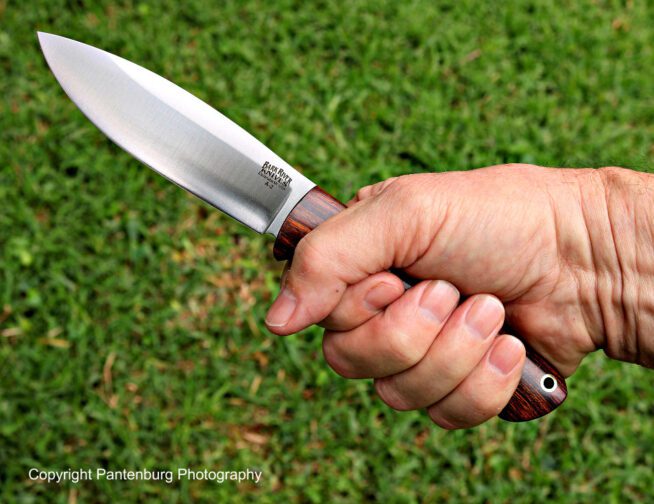

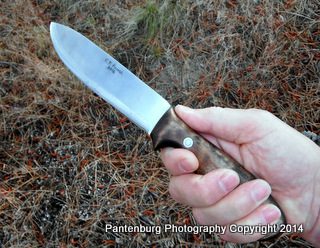
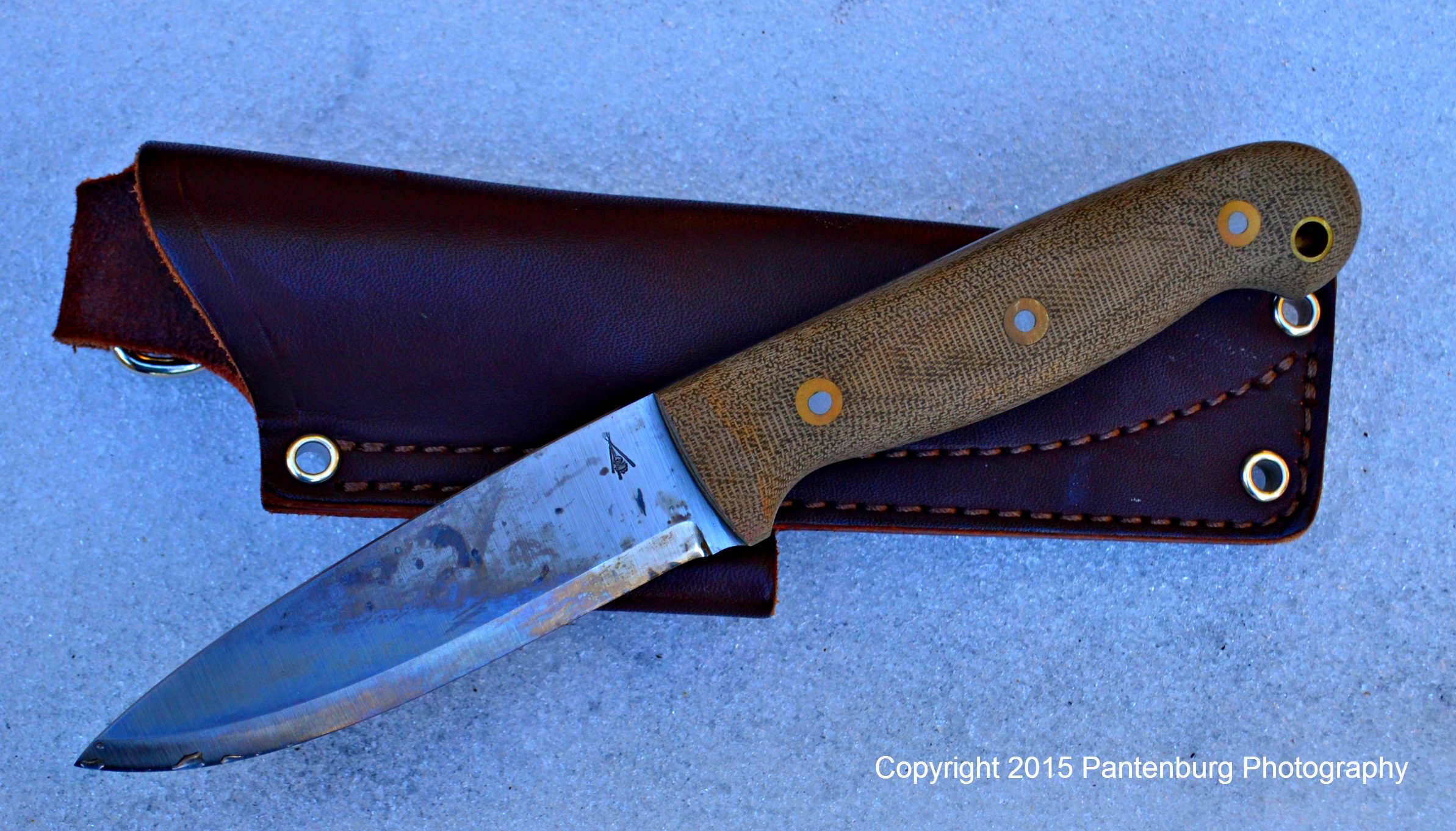
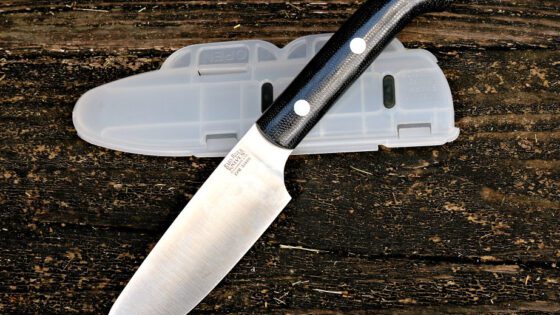
Leave a Reply